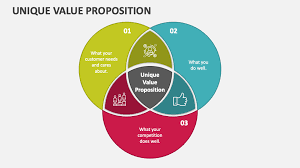A strong Unique Value Proposition (UVP) is now more important than ever in the dynamic world of modern business, where consumers have an abundance of options and digital marketplaces are crowded with rivals. By June 2025, brands will need to move past catchphrases and shallow messaging due to increased market competition and rising consumer expectations. In addition to stating what your company provides, a well-written UVP strategically communicates why your brand is unique.
Knowing the True Significance of a UVP
A unique value proposition is a succinct and understandable statement of the main advantage that sets a business apart from its rivals. It is a statement that speaks to the customer's problems and explains how the brand solves a problem more effectively, more quickly, or more affordably than competitors in the same industry. It is not just a tagline or catchy phrase.
A UVP needs to provide answers to three key questions in order to be effective: What is the purpose of your product or service? For whom is it intended? And why is it superior to or distinct from the current state of affairs? Businesses that are unable to provide clear answers to these questions frequently find it difficult to succeed in cutthroat marketplaces.
The Value of a UVP in the Current Business Climate
Customers are more knowledgeable, astute, and value-driven than ever in 2025. They are no longer influenced by meaningless marketing jargon because they have easy access to comparison tools, customer reviews, and product information. Rather, they seek clarity, relevance, and authenticity.
By establishing the brand as a solution that recognises and caters to the needs of its target market, a strong UVP assists businesses in meeting these expectations. In addition to drawing attention, a UVP assists in turning leads into devoted clients. It shapes the customer journey, establishes the tone for marketing campaigns, and unites your internal teams behind a shared goal. Additionally, it forms the basis for branding, long-term market positioning, and storytelling.
How to Create a Powerful, Distinct Value Proposition
1. Recognise Your Viewers
Gaining a thorough understanding of your target audience is the first step in creating an engaging UVP. This entails creating customer personas, researching the market, and identifying pain points. You must understand your audience's desires, as well as the reasons behind them, the difficulties they encounter, and the factors that influence their choices.
CRM software, social listening tools, and AI-driven analytics platforms are examples of contemporary tools that can offer deep insights into customer behaviour. Finding out what your customers actually value—the foundation of your UVP—requires these insights.
2. Examine Your Rivals
A UVP relies heavily on differentiation. You need to research your competitors to find out how your offering differs. Examine their customer engagement tactics, pricing, product features, and messaging. Determine their strong points, areas for improvement, and areas where your brand can step in.
Direct competitors shouldn't be the only subject of this analysis. Think about alternative goods and services as well as new businesses that might not be well-known yet but have the potential to cause a stir. You can position your brand more accurately the more you know about the market environment.
3. Determine the Special Advantages of Your Brand
Whether it's innovative products, outstanding customer service, ethical sourcing, or affordability, every brand has a unique selling point. Finding and expressing your most valuable and pertinent strength that fits the needs of your audience is crucial. An honest evaluation of your offerings is necessary at this point.
What can your brand reliably and remarkably produce? Steer clear of ambiguous statements like "best service" or "high quality"—these are overused and subjective. Instead, emphasise measurable qualities that can be verified, like "made with 100% recycled materials," "delivers results in 24 hours," or "trusted by over one million users."
4. Craft and Evaluate Your Message
After determining your core value, turn it into a succinct and understandable message. A powerful UVP should blend in seamlessly with your branding and marketing collateral and be comprehensible in less than ten seconds. It should ideally be noticeable on your sales presentations, landing pages, social media bios, and homepage.
To find out which version of your UVP appeals to your audience the most, think about A/B testing it. Experiment with tone, structure, and emphasis through social media posts, paid advertisements, and email campaigns. Your final message should be guided by the data.
5. Internal Alignment
You should embrace your UVP internally as well as for external audiences. The UVP must be understood and embraced by your staff, particularly those in customer-facing positions.
The company culture, internal communications, and training should all support the brand promise stated in your UVP. Internal teams can better deliver on the value proposition and give customers a consistent, genuine experience across all touchpoints when they are in alignment with it.
Instances of Successful UVPs in 2025
In 2025, a number of brands are demonstrating how a unique and unambiguous UVP can spur expansion and client loyalty. For example, a Nigerian fintech company has gained traction by offering “banking with zero hidden fees, built for the everyday Nigerian.” Because it tackles a particular issue—the lack of trust in traditional banking—and provides an open, locally relevant solution, this UVP is appealing.
The UVP "Rewear, Reuse, Reinvent – Fashion That Saves the Planet" has also helped a sustainable fashion brand carve out a niche. This message has helped the brand connect with environmentally conscious consumers in a market that is becoming more aware of environmental impact. It has also helped the brand grow naturally through advocacy and word-of-mouth.
